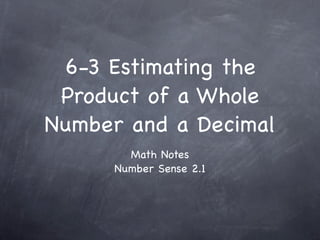
6-3 Estimating the Product of a Whole Number and a Decimal
- 1. 6-3 Estimating the Product of a Whole Number and a Decimal Math Notes Number Sense 2.1
- 2. Estimate 52 x 8.9 52 x 8.9
- 3. Estimate 52 x 8.9 STEP ONE: Estimate by rounding each number to the greatest place that has a NONZERO digit. 52 x 8.9
- 4. Estimate 52 x 8.9 STEP ONE: Estimate by rounding each number to the greatest place that has a NONZERO digit. 52 x 8.9 Remember, do not round any single digit factors.
- 5. Estimate 52 x 8.9 STEP ONE: Estimate by rounding each number to the greatest place that has a NONZERO digit. 52 x 8.9 Remember, do not round any single digit factors.
- 6. Estimate 52 x 8.9 STEP ONE: Estimate by rounding each number to the greatest place that has a NONZERO digit. 52 x 8.9 Remember, do not round any single digit factors.
- 7. Estimate 52 x 8.9 STEP ONE: Estimate by rounding each number to the greatest place that has a NONZERO digit. 52 x 8.9 50 Remember, do not round any single digit factors.
- 8. Estimate 52 x 8.9 STEP ONE: Estimate by rounding each number to the greatest place that has a NONZERO digit. 52 x 8.9 50 Remember, do not round any single digit factors.
- 9. Estimate 52 x 8.9 STEP ONE: Estimate by rounding each number to the greatest place that has a NONZERO digit. 52 x 8.9 50 Remember, do not round any single digit factors.
- 10. Estimate 52 x 8.9 STEP ONE: Estimate by rounding each number to the greatest place that has a NONZERO digit. 52 x 8.9 50 x 9 = Remember, do not round any single digit factors.
- 11. Estimate 52 x 8.9 STEP ONE: Estimate by rounding each number to the greatest place that has a NONZERO digit. 52 x 8.9 50 x 9 = 450 Remember, do not round any single digit factors.
- 12. Estimate 825 x 0.46 825 x 0.46
- 13. Estimate 825 x 0.46 STEP ONE: Estimate by rounding each number to the greatest place that has a NONZERO digit. 825 x 0.46
- 14. Estimate 825 x 0.46 STEP ONE: Estimate by rounding each number to the greatest place that has a NONZERO digit. 825 x 0.46 Remember, do not round any single digit factors.
- 15. Estimate 825 x 0.46 STEP ONE: Estimate by rounding each number to the greatest place that has a NONZERO digit. 825 x 0.46 Remember, do not round any single digit factors.
- 16. Estimate 825 x 0.46 STEP ONE: Estimate by rounding each number to the greatest place that has a NONZERO digit. 825 x 0.46 Remember, do not round any single digit factors.
- 17. Estimate 825 x 0.46 STEP ONE: Estimate by rounding each number to the greatest place that has a NONZERO digit. 825 x 0.46 Remember, do not round any single digit factors.
- 18. Estimate 825 x 0.46 STEP ONE: Estimate by rounding each number to the greatest place that has a NONZERO digit. 825 x 0.46 800 Remember, do not round any single digit factors.
- 19. Estimate 825 x 0.46 STEP ONE: Estimate by rounding each number to the greatest place that has a NONZERO digit. 825 x 0.46 800 Remember, do not round any single digit factors.
- 20. Estimate 825 x 0.46 STEP ONE: Estimate by rounding each number to the greatest place that has a NONZERO digit. 825 x 0.46 800 Remember, do not round any single digit factors.
- 21. Estimate 825 x 0.46 STEP ONE: Estimate by rounding each number to the greatest place that has a NONZERO digit. 825 x 0.46 800 Remember, do not round any single digit factors.
- 22. Estimate 825 x 0.46 STEP ONE: Estimate by rounding each number to the greatest place that has a NONZERO digit. 825 x 0.46 800 x 0.5 = Remember, do not round any single digit factors.
- 23. Estimate 825 x 0.46 STEP ONE: Estimate by rounding each number to the greatest place that has a NONZERO digit. 825 x 0.46 800 x 0.5 = 4000 Remember, do not round any single digit factors.
- 24. Estimate 825 x 0.46 STEP ONE: Estimate by rounding each number to the greatest place that has a NONZERO digit. 825 x 0.46 800 x 0.5 = 4000 Remember, do not round any single digit factors.
- 25. Estimate 825 x 0.46 STEP ONE: Estimate by rounding each number to the greatest place that has a NONZERO digit. 825 x 0.46 800 x 0.5 = 4000 Remember, do not round any single digit factors.
- 26. Estimate 825 x 0.46 STEP ONE: Estimate by rounding each number to the greatest place that has a NONZERO digit. 825 x 0.46 800 x 0.5 = 4000 . Remember, do not round any single digit factors.
Hinweis der Redaktion
- \n
- \n
- \n
- \n
- \n
- \n
- \n
- \n
- \n
- \n
- \n
- \n
- \n
- \n
- \n
- \n
- \n
- \n
- \n
- \n
- \n
- \n
- \n
- \n
- \n
- \n
- \n
- \n
- \n
- \n
